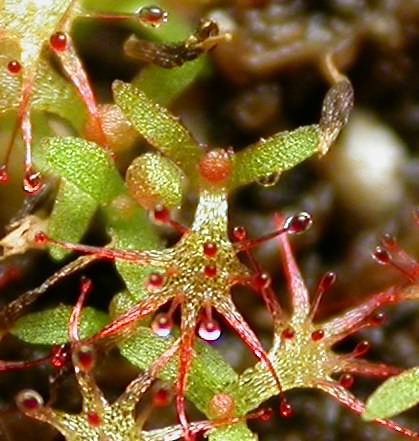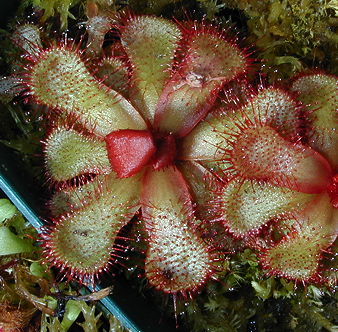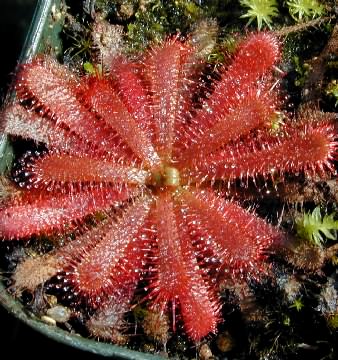
Drosera species that could be classed as subtropicals are found in South America, southern Africa, southern and eastern Asia, and Australia. There are at least a hundred species of Drosera in these regions. Some such as the tuberous, pygmy, and woolly sundews of Australia and a few Drosera from South Africa are special cases that need to be considered separately because of their particular requirements. But most subtropical Drosera are just variations on the same theme. They have been referred to as DRS's or <expletive> rosetted sundews because they are so hard to tell apart without ripping off leaves and checking flowers and seeds under a hand lens.
Among Drosera species, the subtropicals usually make the best terrarium and greenhouse sundews. They generally do well in a moderate temperature range of 10°C to 35°C (50°F to 95°F) and don't have dormancy or light cue requirements to survive long term. They may need light queues to bloom but you do not grow these Drosera for the flowers. Subtropical Drosera do tend to prefer higher humidity than is typical in houses and want more light than they can get on a window sill. But there are successful growers who keep their plants under artificial lights on shelves away from drafts.
Many subtropical Drosera are long lived. You can keep most species indefinitely with repotting every 3 to 5 years. Even annuals such as Drosera burmannii can live for years if you remove flower stalks as soon as they appear and feed them well. If the plants do start to decline and feeding does not help, propagating is easy from stem, root, or leaf cuttings. Root and stem cuttings will give you new mature plants relatively quickly. Leaf cuttings are not as quick but faster than seeds.
Most subtropical Drosera are not very picky about soil. They can grow well in pure Sphagnum moss, live, long fibered or shredded, as well as the standard peat:sand "CP mix" which can be anything from 30% to 100% peat. Growing plants in CP mix with live sphagnum on top is very effective for the larger or stalk forming species. Things to watch for are inferior grades of sphagnum and peat and non-silica sand. Read the bags carefully to make sure there is no added fertilizer. The best Sphagnum is from New Zealand and Chile. For peat look for Canadian or German Sphagnum peat. The best sand is uniform size sand-blasting silica sand about 1.2 mm in diameter (12 to 16 mesh in USA).
Everyone has their favorite seed planting medium. They also have anecdotes to tell why their way is so wonderful and the way everyone else does it is, well, you know. You just have to find what works best for you given the materials you have available and the conditions you can provide. You can try a high proportion of sand, putting sulfur in the soil, using sterilized material, waving a magic wand. They all work for some people. And then there are pots. Don't get me started on pots! Some people have obsessions about round vs. square, tall vs. short, large vs. small. IT DOESN'T MATTER. Mostly.
One thing there is no argument about is you sow seeds on the surface of your medium of choice. Don't bury the seeds. For any seeds but bog plant seeds, you don't top water a seedling pot. It can be fatal. With Drosera it is different. The soil surface should be lightly misted after the seeds are placed. It helps germination and settles the seed around large sand particles. Make sure you label the pots and include the date so when it seems like forever since you planted the seeds you can see it has only been a few weeks. Some seeds may take a month or more to germinate. Some do require warmer or cooler temperatures so if one location is not working, try a different one.
What you do next depends on what works best for you. Everyone has their own preferred routine. I put pots with seeds in plastic zip-lock bags under LED lights. If you only have fluorescent lights, take care that the bags with the pots are far enough away from the lights so you do not cook the seedlings. You could also use an aquarium in a greenhouse. The purpose of the plastic bag is to maintain very high humidity and to keep out fungus gnats. Fungus gnat larvae will eat the seedlings. A temperature between 20°C to 25°C (70°F to 80°F) works best for most subtropicals. The seeds should germinate in a few weeks. When the new plants have a few true leaves, you can remove the pots from the plastic bags and put them in a bright terrarium or greenhouse. However, as long as you are not having problems with nasty moss or other things that can grow on the soil, it is best to leave them in the bags until they get large enough to not be killed by fungus gnat larvae. Please see Sowing Seeds Step-by-Step for more details on starting seeds.
Most Drosera seeds are small and result in tiny, slow growing seedlings. It takes patience to grow carnivores from seed. The biggest problem in starting seeds is usually dealing with the moss, fungi, and cyanobacteria (blue-green algae) found naturally in the Sphagnum and peat. It is not uncommon to transplant seedlings into new media a few times as the seedlings get overwhelmed with guk. Use a fine forceps, bright light, and magnifying glass. Be careful not to damage the roots.
Once the plants are large enough you can try feeding them small insects or get some dried blood worms at a pet shop. The dried blood worms can be soaked in water and placed on the dewy leaves—only feed a plant that is dewy and only with live or wet food. If the food gets moldy, use less next time. A dab of 70% isopropanol (rubbing alcohol) from a small paint brush will help control the fungus.
Do not put fertilizer of any kind in the soil. If it it does not directly kill the plants, it will change the soil chemistry which may make the plants rather unhappy. Once the plants are more than a cm wide they do respond to light misting with dilute, high nitrogen fertilizer. It is best to use hydrated dried blood worms on the leaves instead of spraying with fertilizer, but if you feel you must use fertilizer, use foliar fertilizer with care.
It can easily take two years to get mature plants. The hardest part is getting the seedlings to a size you can feed them with hydrated dried blood worms. Once you can do that the plants should grow quite quickly.
-- John Brittnacher
For more information please see:
Christophe, Alain (1981) A South African Insectivorous Plant Trip. Carniv. Pl. Newslett. 10(4):96-101 ( PDF )
Chandler, Graeme (1978) The Uptake of Digestion Products by Drosera. Carniv. Pl. Newslett. 7(1):11-13 ( Part 1 PDF )
Chandler, Graeme (1978) The Uptake of Digestion Products by Drosera. Carniv. Pl. Newslett. 7(2):51-54 ( Part 2 PDF )
Nolan, Garry (1978) On the Foraging Strategies of Carnivorous Plants: II. Biological Stimulus versus Mechanical Stimulus in the Fast-Moving Periphery Tentacles of the Species Drosera burmanni. Carniv. Pl. Newslett. 7(3):79-81 ( PDF )
Haberlandt, Gottlieb (from Sinnesorgane Im Pflanzenreich, Trans. By Carla R. Powell) (1982) Insectivores: Drosera and Drosophyllum. Carniv. Pl. Newslett. 11(3):66-73 (PDF )

Drosera aliciae. These plants are 5 cm across.

Seedlings with one true leaf.

Drosera dielsiana. This plant is 3cm across.

Drosera natalensis, from South Africa.

Drosera latifolia from South America.

Drosera venusta from South Africa. This species grows best under cool conditions.

Drosera slackii, another South African.

Drosera trinervia.

Drosera madagascariensis from Botswana in a 5 cm pot. This species grows seasonally and prefers very warm temperatures.

Drosera admirabilis from South Africa. This plant is 25 mm across. It is a few years old. This species generally looks like a miniature Drosera aliciae although some taxonomists confuse it with D. cuneifolia.

Drosera nidiformis. These plants are in a 5 cm pot.
